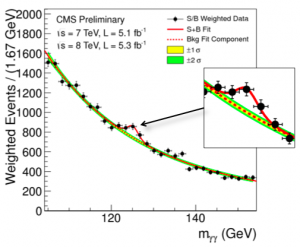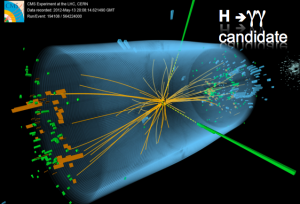
The data from CMS showing the evidence for the existence of a new particle that decays into two photons.
Although predicted but undiscovered until recently, the Higgs now appears to have been found by the ATLAS and CMS experiments at the Large Hadron Collider (LHC) at the CERN laboratory in Geneva. Why is this such a Big Deal?
The Vacuum Isn’t Empty!
The discovery of the Higgs boson is more exciting than discovering the existence of just another elementary particle. This is because its discovery would provide the first experimental evidence for a radical theoretical proposal that was made back in the 1960’s.
Back in the 1960’s, a fundamental dilemma arose in particle physics. As had become clear by then, Nature has four fundamental interactions – gravitational, electromagnetic, the strong force (the force that holds together atomic nuclei) and the weak force (the one responsible for radioactive decays). Once these interactions became understood a puzzle arose: in order for a particle to take part in the weak interactions it appeared to have to move at the speed of light. In physics-speak: a particle couldn’t have a mass if it took part in the weak interactions. But electrons are examples of particles we know don’t move at the speed of light (and so have mass), but still take part in the weak interactions (since they can be emitted in radioactive decays, called beta decays).
Peter Higgs (as well as several others: Brout, Englert, Guralnik, Hagen and Kibble) found a theoretical resolution to this puzzle, which required a very radical re-interpretation of what the vacuum is. Normally we think of the vacuum as just being the thing that has nothing in it. But they proposed instead that the vacuum is a physical thing which has physical properties, with which elementary particles can interact. There is an energy associated with this interaction, which we interpret as the particle mass due to Einstein’s relation E = m c2.

Event display from the CMS detector of a candidate event with a Higgs boson decaying into two light rays. This extremely energetic collision results in many low energy debris as well as two very high energy light rays.
At CERN they have just provided the first experimental evidence that this picture of the vacuum having physical properties is right. They did so by exciting a wave in the vacuum, which in their experiment looks like a new type of particle.
Like a Fish out of Water
You can think of the whole picture as an analogy where elementary particles are replaced by fish. Suppose you were interested in the properties of fish and how they move and why some fish move faster than others given the same amount of effort. This would be very hard if you did not understand what water was. In order to understand properly the motion of fish, you must first also understand the environment through which they move.
Now ichthyologists never doubted the existence of water because, unlike the fish, they (the ichthyologists) do not live in it. If ichthyologists were themselves fish it might be easier to take water for granted and so it might appear radical to propose its existence as a hitherto unseen environment. The acid test would be to move the water, or to excite a water wave, since that would show that there was something “there” besides just fish.
So the radical theoretical proposal is that we are all moving through a medium (called the “Higgs field”), and it is the properties of this medium that partially control the behaviour of elementary particles. Again the acid test is to perturb the vacuum and excite a wave in it. This is what the experiments have CERN seem to have done for the very first time.
This is important because the assertion that the vacuum has physical properties is a very radical idea. Theorists were sure that it had to be true because we know of no other way to reconcile the weak interactions with elementary particle masses. But experimentalists are the final arbiters of reality, and there is no substitute for having an experimental foundation for such a deep change to our picture of nature.
Where To From Here?
We have a very successful theory called the Standard Model, which makes specific predictions for what the vacuum’s properties are. But there are other theories as well, and all of these describe particle mass in terms of vacuum properties. They do differ from the Standard Model on precisely what the vacuum is like, and so also differ about what kinds of waves (or Higgs particles) can be excited. Having discovered these waves, we can now explore their properties to see which of these theories is right. (So far, the experiments at CERN are consistent with the Standard Model version. There is one hint of a disagreement with the Standard Model, but the uncertainty on the measurement is still too large to be absolutely sure.)
Another class of questions asks: if the vacuum has properties, can these vary from place to place or at different times? To go back to the fish example, if you put a pot of fish on the stove or in the freezer, the changing properties of the water will have a huge impact on the behaviour of the fish in the pot. We have reasons to believe that when the universe was very young that it was much hotter than it is now, and so the vacuum very probably underwent a transition like water freezing. Clearly this can be important for understanding what the early universe might have been like.
How will this change the average person’s life?
As always with curiosity-driven science it is very difficult to know what the spin-offs will be before they arise.
In some ways the experiments that found the Higgs already have changed ordinary peoples’ lives. One of the challenges the experimenters faced in the early 1990’s was how to plan to analyze all of the data that this experiment would produce. To solve it, scientists at CERN (building on the previously built internet) developed the world-wide web as a simple way for experimenters to deal with data around the world, just by clicking on things with a mouse. It is this software that made the internet into something the public could use, and has transformed our lives ever since.
Probably the most important spin-off we do know about is people. The economy is full of people with mathematical problem-solving skills, from engineers to computer programmers and mathematical bankers (“quants”). Many of these acquired their skills because they were drawn to universities to learn them by the cool ideas in particle physics (or astronomy or other areas of mathematical sciences). These people have a huge impact on all of our lives because they are a spinoff of huge value to the economy as a whole.